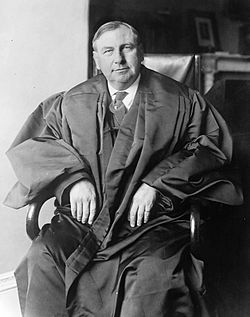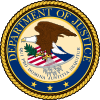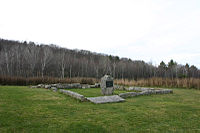- Harlan F. Stone
-
Harlan F. Stone 
12th Chief Justice of the United States In office
July 3, 1941 – April 22, 1946Nominated by Franklin Delano Roosevelt Preceded by Charles Evans Hughes Succeeded by Fred M. Vinson Associate Justice of the United States Supreme Court In office
February 5, 1925[1] – July 3, 1941Nominated by Calvin Coolidge Preceded by Joseph McKenna Succeeded by Robert H. Jackson 52nd United States Attorney General In office
April 7, 1924 – March 1, 1925Nominated by Calvin Coolidge Preceded by Harry M. Daugherty Succeeded by John G. Sargent Personal details Born Harlan Fiske Stone
October 11, 1872
Chesterfield, New Hampshire
United StatesDied April 22, 1946 (aged 73)
Washington, DC
United StatesAlma mater Amherst College,
Columbia UniversityHarlan Fiske Stone (October 11, 1872 – April 22, 1946) was an American lawyer and jurist. A native of New Hampshire, he served as the dean of Columbia Law School, his alma mater, in the early 20th century. As a member of the Republican Party, he was appointed as the 52nd Attorney General of the United States before becoming an Associate Justice of the U.S. Supreme Court in 1925. In 1941, Stone became the 12th Chief Justice of the court, serving until his death in 1946 – one of the shortest terms of any Chief Justice.[2] Stone was the first Chief Justice not to have served in elected office.
Contents
Early years
Stone was born in Chesterfield, New Hampshire, to Fred L. and Ann S. (Butler) Stone. He prepared at Amherst High School, and graduated Phi Beta Kappa[3] from Amherst College in 1894.
From 1894 to 1895 he was the submaster of Newburyport High School. From 1895 to 1896 he was an instructor in history at Adelphi Academy in Brooklyn, New York. He also received his M.A. from Amherst College in 1897.[4]
Legal career
Stone attended Columbia Law School from 1895 to 1898, received an LL.B., and was admitted to the New York bar in 1898.[4] Stone practiced law in New York City, initially as a member of the firm Satterlee, Sullivan & Stone, and later as a partner in the firm Sullivan & Cromwell. From 1899 to 1902 he lectured on law at Columbia Law School. He was a professor there from 1902 to 1905 and eventually served as the school's dean from 1910 to 1923.[4] He lived in The Colosseum, an apartment building near campus.
During World War I, Stone served for several months on a War Department Board of Inquiry, with Major Walter Kellogg of the U.S. Army Judge Advocate Corps and Judge Julian Mack, that reviewed the cases of 2,294 men whose requests for conscientious objector status had been denied by their draft boards. The Board was charged with determining the sincerity of each man's principles, but often devoted only a few minutes to interrogation and rendering a decision. Stone was impatient with men who took advantage of the benefits of life in America–using postage stamps was his example–without accepting the burdens of citizenship. In a majority of cases, the Board's subjects either relinquished their claims or were judged insincere. He later summarized his experience with little sympathy: "The great mass of our citizens subordinated their individual conscience and their opinions to the good of the common cause" while "there was a residue whose peculiar beliefs...refused to yield to the opinions of others or to force." Nevertheless, he recognized the courage required to persist as a conscientious objector: "The Army was not a bed of roses for the conscientious objector; and the normal man who was not supported in his stand by profound moral conviction might well have chosen active duty at the front as the easier lot."[5]
At the end of the war, he criticized Attorney General A. Mitchell Palmer for his attempts to deport aliens based on administrative action without allowing for any judicial review of their cases.[6]
In 1924, he was appointed United States Attorney General by his Amherst classmate President Calvin Coolidge. As Attorney General, Stone was responsible for the appointment of J. Edgar Hoover as head of the Department of Justice's Bureau of Investigation,[7] which later became the Federal Bureau of Investigation (FBI).
Associate Justice
On January 5, 1925, Stone was appointed an Associate Justice of the United States Supreme Court to a seat vacated by Joseph McKenna, becoming Coolidge's only appointment to the Court. He was confirmed by the United States Senate on February 5 and received his commission the same day.[4]
During the 1932–1937 Supreme Court terms, Stone and his colleagues Justices Brandeis and Cardozo were considered the Three Musketeers of the Supreme Court, its liberal faction. The three were highly supportive of President Roosevelt's New Deal programs, which many other Supreme Court Justices opposed. For example, he wrote for the court in United States v. Darby Lumber Co.,[8] 312 U.S. 100 (1941), which upheld challenged provisions of the Fair Labor Standards Act of 1938. Stone also authored the Court's opinion in United States v. Carolene Products Co.,[9] 304 U.S. 144 (1938), which, in its famous "Footnote 4," provided a roadmap for judicial review in the post-Lochner v. New York era.
Stone's support of the New Deal brought him Roosevelt's favor, and on June 12, 1941, the President elevated him to Chief Justice, a position vacated by Charles Evans Hughes. Stone was confirmed by the United States Senate on June 27 and received his commission on July 3. He remained in this position for the rest of his life.[4]
Chief Justice
As Chief Justice, Stone spoke for the Court in upholding the President's power to try Nazi saboteurs captured on American soil by military tribunals in Ex parte Quirin,[10] 317 U.S. 1 (1942). The court's handling of this case has been the subject of scrutiny and controversy.[11]
Stone also wrote one of the major opinions in establishing the standard for state courts to have personal jurisdiction over litigants in International Shoe Co. v. Washington,[12] 326 U.S. 310 (1945).
As Chief Justice, Stone described the Nuremberg court as "a fraud" to Germans.[13]
He opposed overturning precedents that would have barred a Seventh-day Adventist from being naturalized as a U.S. citizen if he refused to take up military arms during wartime despite being willing to serve as a conscientious objector.
Stone was the fourth Chief Justice to have previously served as an Associate Justice and the second to have served in both positions consecutively.[14] To date, Justice Stone is the only justice to have occupied all nine seniority positions on the bench, having moved from most junior Associate Justice to most senior Associate Justice and then to Chief Justice.
In 1946, at the age of 73, Stone died of a cerebral hemorrhage that struck while Justice Douglas was reading the majority opinion in Girouard v. United States from the bench; Stone had planned to read his dissent afterwards.[15] He is the only Supreme Court Justice to have died during an open court session.
Other activities
Stone was the director of the Atlanta & Charlotte Air Line Railroad Company, the president of the Association of American Law Schools, and a member of the American Bar Association.
He was awarded an honorary master of arts degree from Amherst College in 1900, and an honorary Doctor of Laws degree from Amherst in 1913. Yale awarded him an honorary doctor of laws degree in 1924. Columbia and Williams each awarded him the same honorary degree in 1925.
Stone married Agnes E. Harvey in 1899. Their children were Lauson H. Stone and the mathematician Marshall H. Stone. Stone is buried at Rock Creek Cemetery in the Petworth neighborhood of Washington, D.C.[16][17] His burial is said to be "quite neighborly with other Justices even after death." Four justices buried in Rock Creek "are essentially paired off." Justice Willis Van Devanter is in a family plot within 40 yards of the senior John Marshall Harlan. Chief Justice and Mrs. Harlan Fiske Stone have a "handsome memorial" within 25 yards of Stephen Johnson Field's "imposing black obelisk".[16]
See also
- List of United States Chief Justices by time in office
- List of U.S. Supreme Court Justices by time in office
- United States Supreme Court cases during the Stone Court
Notes
- ^ "Federal Judicial Center: Harlan Fiske Stone". 2009-12-12. http://web.archive.org/web/20060926205536/http://www.fjc.gov/servlet/tGetInfo?jid=2299. Retrieved 2009-12-12.
- ^ Ariens, Michael, Harlan Fiske Stone
- ^ Supreme Court Justices Who Are Phi Beta Kappa Members, Phi Beta Kappa website, accessed Oct 4, 2009
- ^ a b c d e
- Harlan F. Stone at the Biographical Directory of Federal Judges, a public domain publication of the Federal Judicial Center.
- ^ Christopher Capozzola, Uncle Sam Wants You: World War I and the Making of the Modern American Citizen (NY: Oxford University Press, 2008), 57, 59–60, 66, 70, 73–4, 76, 82
- ^ Capozzola, 203
- ^ Another Hoover, TIME Magazine, December 29, 1924
- ^ UNITED STATES V. DARBY, 312 U. S. 100 (1941)
- ^ UNITED STATES V. CAROLENE PRODUCTS CO., 304 U. S. 144 (1938)
- ^ EX PARTE QUIRIN, 317 U. S. 1 (1942)
- ^ BRIEF OF LEGAL SCHOLARS AND HISTORIANS AS AMICI CURIAE IN SUPPORT OF PETITIONER, SALIM AHMED HAMDAN, v DONALD H. RUMSFELD, SECRETARY OF DEFENSE, et al., No. 05-184
- ^ INTERNATIONAL SHOE V. STATE OF WASHINGTON, 326 U. S. 310 (1945)
- ^ Mason, Alpheus T., Harlan Fiske Stone: Pillar of the Law, NY: Viking, 1956, p. 716
- ^ John Rutledge and Charles Evans Hughes had each retired from the Court before being reappointed as Chief Justice.
- ^ Stevens, John Paul (2011). "The First Twelve Chiefs". Five Chiefs. Little, Brown and Company. p. 36. ISBN 978-0-316-19980-3. OCLC 751749249.
- ^ a b Christensen, George A. (1983) Here Lies the Supreme Court: Gravesites of the Justices, Yearbook Supreme Court Historical Society at Internet Archive
- ^ Christensen, George A., "Here Lies the Supreme Court: Revisited," Journal of Supreme Court History, Volume 33 Issue 1, Pages 17–41 (19 Feb 2008), University of Alabama
Sources
- Abraham, Henry J. (1992). Justices and Presidents: A Political History of Appointments to the Supreme Court (3rd ed.). NY: Oxford University Press. ISBN 0-19-506557-3.
- Attorney General biographies, Harlan Fiske Stone, United States Department of Justice.
- Cushman, Clare (2001). The Supreme Court Justices: Illustrated Biographies, 1789–1995 (2nd ed.). (Supreme Court Historical Society, Congressional Quarterly Books). ISBN 1568021267.
- Frank, John P. (1995). Friedman, Leon; Israel, Fred L.. eds. The Justices of the United States Supreme Court: Their Lives and Major Opinions. Chelsea House Publishers. ISBN 0791013774.
- Galston, Miriam. 1995. "Activism and Restraint: The Evolution of Harlan Fiske Stone's Judicial Philosophy," in Tulane Law Review 70 (November).
- Hall, Kermit L., ed (1992). The Oxford Companion to the Supreme Court of the United States. NY: Oxford University Press. ISBN 0195058356.
- Konefsky, Samuel Joseph. 1945. Chief Justice Stone and the Supreme Court (Reprint, 1971. NY: Hafner)
- Mason, Alpheus Thomas, Harlan Fiske Stone: Pillar of the Law New York, Viking Press, 1956. ISBN 0670369977; ISBN 978-0670369973 Review of Mason, Alpheus Thomas, Harlan Fiske Stone: Pillar of the Law.
- Oyez project, Official Supreme Court media, Harlan Fiske Stone
- Rehnquist, William H. (1998). All the Laws but One: Civil Liberties in Wartime. NY: William Morrow & Co.. ISBN 0-688-05142-1.
- Stone, Harlan Fiske. 2001. Law and Its Administration Union, N.J.: Lawbook Exchange
- Urofsky, Melvin I., Division and Discord: The Supreme Court under Stone and Vinson, 1941–1953 (University of South Carolina Press, 1997) ISBN 1570031207
- Urofsky, Melvin I. (1994). The Supreme Court Justices: A Biographical Dictionary. NY: Garland Publishing. pp. 590. ISBN 0815311761.
External links
- Ariens, Michael, Harlan Fiske Stone.
- Fox, John, Capitalism and Conflict, Biographies of the Robes, Harlan Fiske Stone Public Broadcasting Service.
- Harlan Fiske Stone, Supreme Court Historical Society
- Nash, A. E. Kier, Harlan Fiske Stone, answers.com
- The Stone Court, 1941–1945, History of the Court, Supreme Court Historical Society
- Stone Family Papers, Special Collections, Jones Library, Amherst, MA
- Cover photograph Time Magazine
Legal offices Preceded by
Harry M. DaughertyUnited States Attorney General
Served under: Calvin Coolidge
1924–1925Succeeded by
John G. SargentPreceded by
Joseph McKennaAssociate Justice of the U.S. Supreme Court
1925–1941Succeeded by
Robert H. JacksonPreceded by
Charles Evans HughesChief Justice of the United States
1941–1946Succeeded by
Fred M. VinsonUnited States Attorneys General Randolph • Bradford • Lee • Lincoln • Breckinridge • Rodney • Pinkney • Rush • Wirt • Berrien • Taney • Butler • Grundy • Gilpin • Crittenden • Legaré • Nelson • Mason • Clifford • Toucey • Johnson • Crittenden • Cushing • Black • Stanton • Bates • Speed • Stanbery • Evarts • Hoar • Akerman • Williams • Pierrepont • Taft • Devens • MacVeagh • Brewster • Garland • Miller • Olney • Harmon • McKenna • Griggs • Knox • Moody • Bonaparte • Wickersham • McReynolds • Gregory • Palmer • Daugherty • Stone • Sargent • W D Mitchell • Cummings • Murphy • Jackson • Biddle • T C Clark • McGrath • McGranery • Brownell • Rogers • Kennedy • Katzenbach • W R Clark • J N Mitchell • Kleindienst • Richardson • Saxbe • Levi • Bell • Civiletti • Smith • Meese • Thornburgh • Barr • Reno • Ashcroft • Gonzales • Mukasey • Holder
Cabinet of President Calvin Coolidge (1923–1929) Vice President None (1923–1925) • Charles G. Dawes (1925–1929)
Secretary of State Charles Evans Hughes (1923–1925) • Frank B. Kellogg (1925–1929)Secretary of War John W. Weeks (1923–1925) • Dwight F. Davis (1925–1929)Secretary of the Treasury Andrew W. Mellon (1923–1929)Attorney General Postmaster General Harry Stewart New (1923–1929)Secretary of the Navy Edwin Denby (1923–1924) • Curtis D. Wilbur (1924–1929)Secretary of the Interior Hubert Work (1923–1928) • Roy Owen West (1928–1929)Secretary of the Agriculture Henry Cantwell Wallace (1923–1924) • Howard Mason Gore (1924–1925) • William Marion Jardine (1925–1929)Secretary of Commerce Herbert Hoover (1923–1928) • William F. Whiting (1928–1929)Secretary of Labor James J. Davis (1923–1929)Supreme Court of the United StatesThe Taft Court Chief Justice: William Howard Taft (1921–1930) 1925–1930: O.W. Holmes | W. Van Devanter | J.C. McReynolds | L.D. Brandeis | Geo. Sutherland | P. Butler | E.T. Sanford | H.F. Stone The Hughes Court Chief Justice: Charles Evans Hughes (1930–1941) Feb–Mar 1930: O.W. Holmes | W. Van Devanter | J.C. McReynolds | L.D. Brandeis | Geo. Sutherland | P. Butler | E.T. Sanford | H.F. Stone Jun 1930–1932: O.W. Holmes | W. Van Devanter | J.C. McReynolds | L.D. Brandeis | Geo. Sutherland | P. Butler | H.F. Stone | O.J. Roberts 1932–1937: W. Van Devanter | J.C. McReynolds | L.D. Brandeis | Geo. Sutherland | P. Butler | H.F. Stone | O.J. Roberts | B.N. Cardozo 1937–1938: J.C. McReynolds | L.D. Brandeis | Geo. Sutherland | P. Butler | H.F. Stone | O.J. Roberts | B.N. Cardozo | H. Black 1938: J.C. McReynolds | L.D. Brandeis | P. Butler | H.F. Stone | O.J. Roberts | B.N. Cardozo | H. Black | S.F. Reed 1939: J.C. McReynolds | P. Butler | H.F. Stone | O.J. Roberts | H. Black | S.F. Reed | F. Frankfurter | Wm. O. Douglas 1940–1941: J.C. McReynolds | H.F. Stone | O.J. Roberts | H. Black | S.F. Reed | F. Frankfurter | Wm. O. Douglas | F. Murphy Feb-Jul 1941: H.F. Stone | O.J. Roberts | H. Black | S.F. Reed | F. Frankfurter | Wm. O. Douglas | F. Murphy | (vacancy) The Stone Court Chief Justice: Harlan F. Stone (1941–1946) 1941–1942: O.J. Roberts | H. Black | S.F. Reed | F. Frankfurter | Wm. O. Douglas | F. Murphy | J.F. Byrnes | R.H. Jackson 1943–1945: O.J. Roberts | H. Black | S.F. Reed | F. Frankfurter | Wm. O. Douglas | F. Murphy | R.H. Jackson | W.B. Rutledge 1945–1946: H. Black | S.F. Reed | F. Frankfurter | Wm. O. Douglas | F. Murphy | R.H. Jackson | W.B. Rutledge | H.H. Burton  Categories:
Categories:- Coolidge administration cabinet members
- 1872 births
- 1946 deaths
- Adelphi University faculty
- American Episcopalians
- American legal scholars
- Amherst College alumni
- Chief Justices of the United States
- Columbia Law School alumni
- Columbia Law School faculty
- Columbia University faculty
- Law school deans
- New York lawyers
- United States Attorneys General
- United States federal judges appointed by Calvin Coolidge
- United States federal judges appointed by Franklin D. Roosevelt
- United States Supreme Court justices
- Burials at Rock Creek Cemetery
Wikimedia Foundation. 2010.

